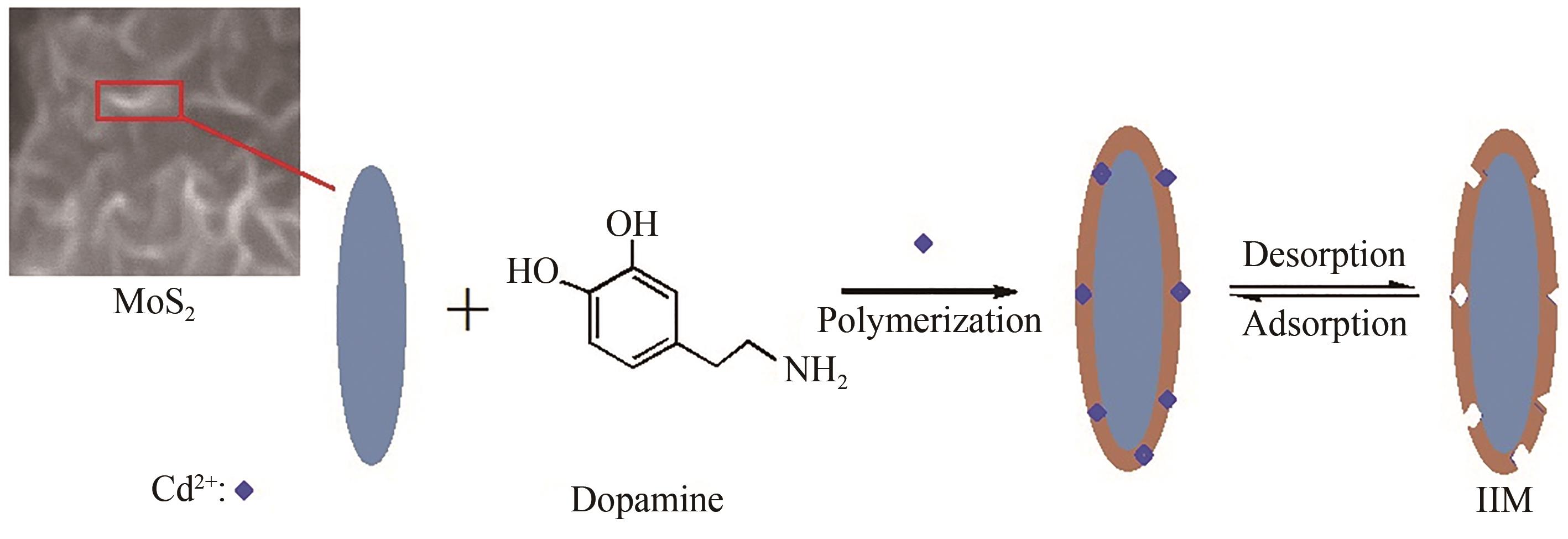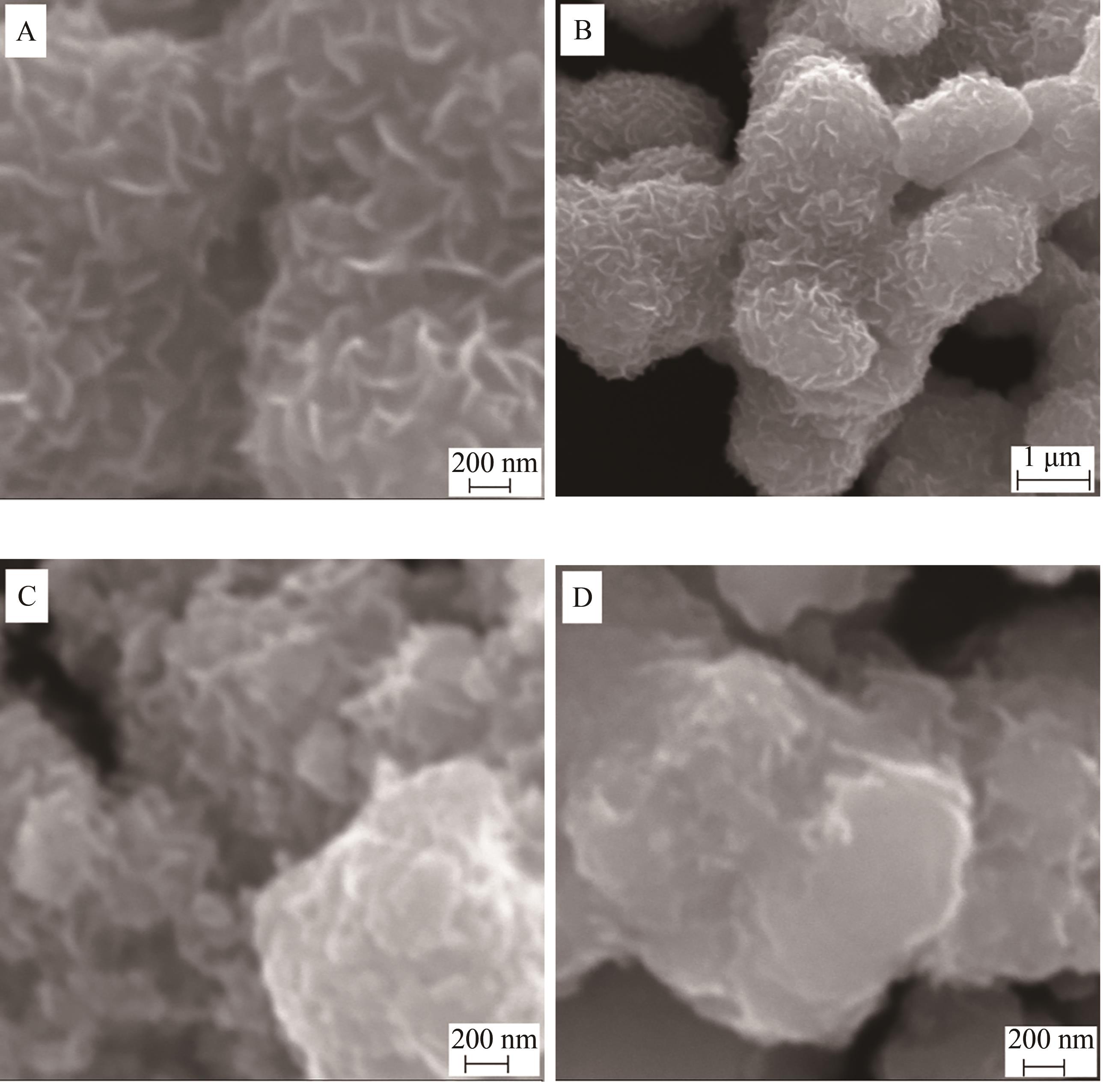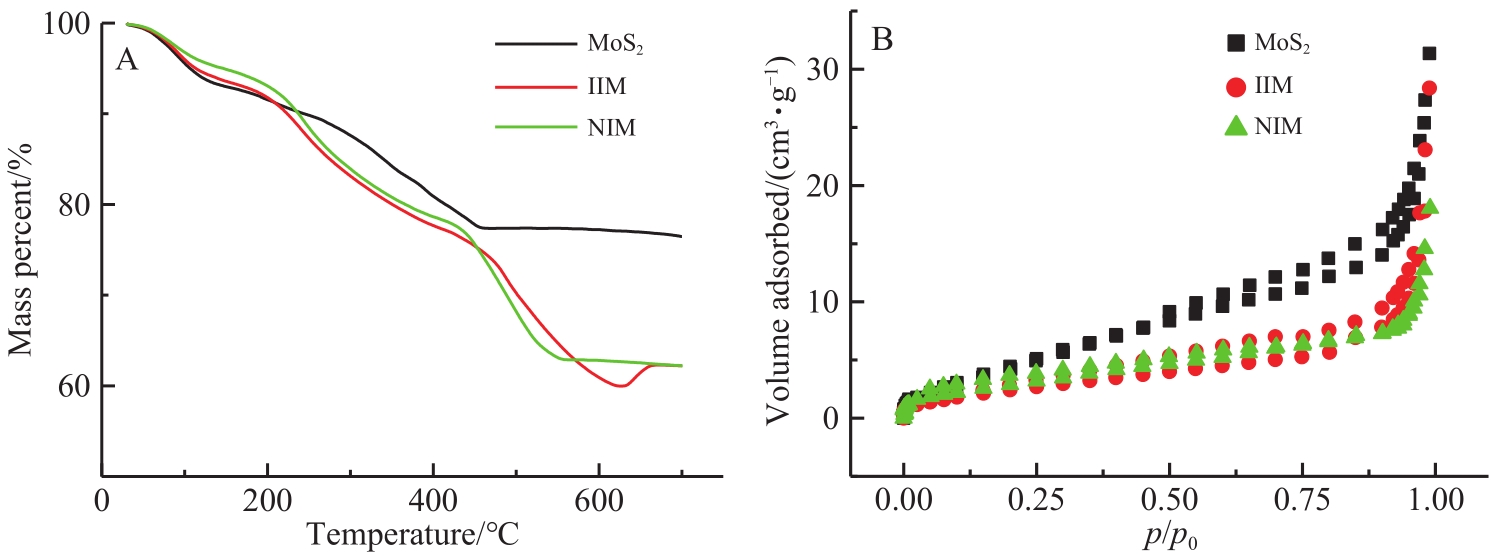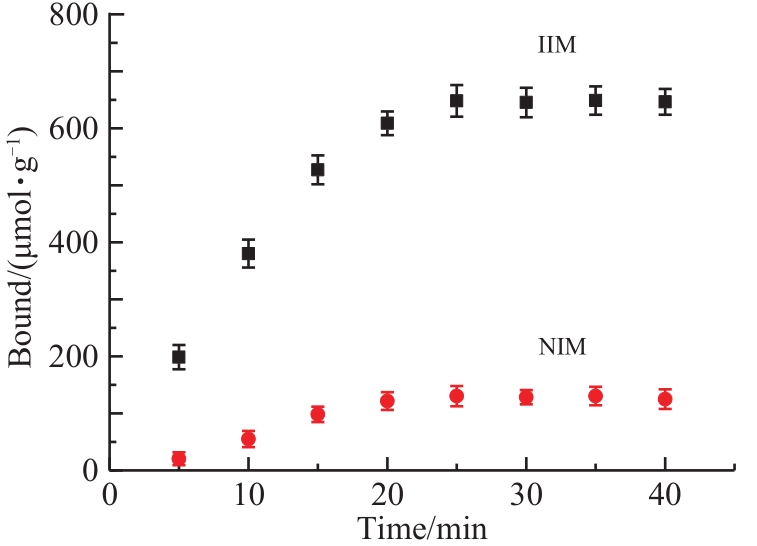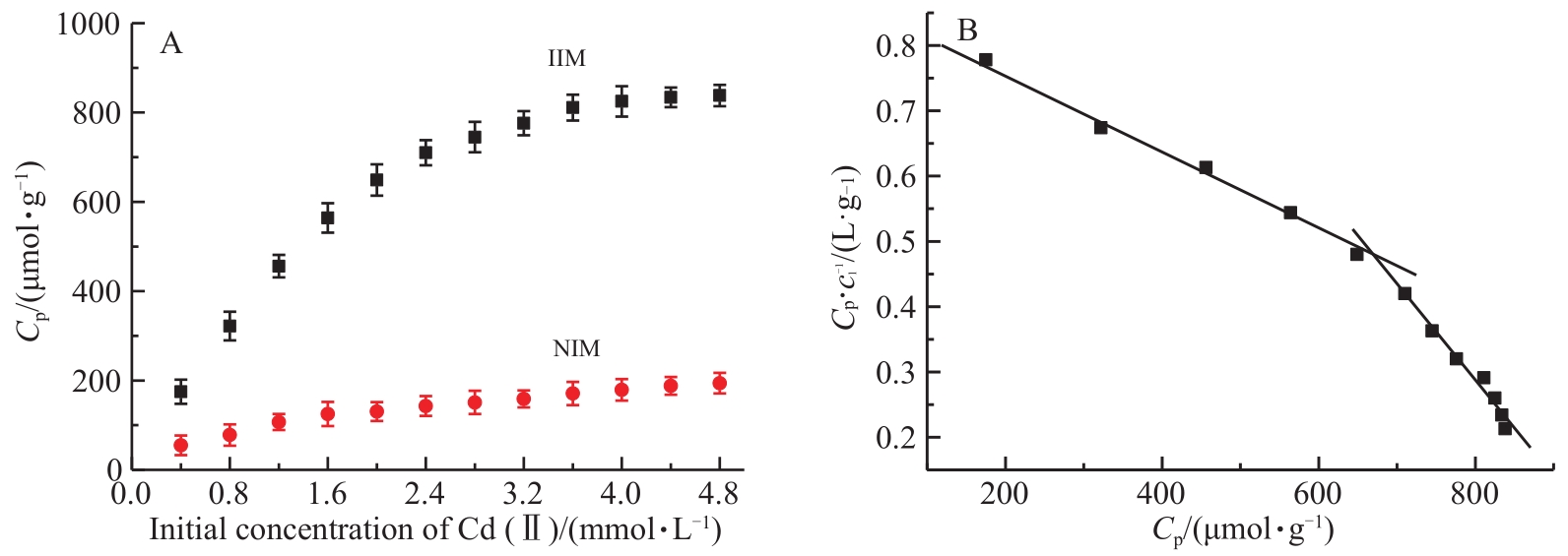
Chinese Journal of Applied Chemistry ›› 2023, Vol. 40 ›› Issue (7): 1024-1033.DOI: 10.19894/j.issn.1000-0518.220411
• Full Papers • Previous Articles Next Articles
Preparation and Properties of Surface Ion Imprinted Material Based on Molybdenum Disulfide Nanoflowers
Yan-Bin WU, Li-Zhen LI, Jun-Hua LI, Zhi-Feng XU( )
)
- College of Chemistry and Materials Science,Hengyang Normal University; Key Laboratory of Functional Organometallic Compounds of Hunan Province; Engineering Research Center for Monitoring and Treatment of Heavy Metals Pollution in the Upper Reaches of Xiangjiang River,Hengyang 421008,China
-
Received:2022-12-25Accepted:2023-06-10Published:2023-07-01Online:2023-07-19 -
Contact:Zhi-Feng XU -
About author:1760321030@qq.com
-
Supported by:the Scientific Research Fund of Hunan Provincial Education Department(20A073)
CLC Number:
Cite this article
Yan-Bin WU, Li-Zhen LI, Jun-Hua LI, Zhi-Feng XU. Preparation and Properties of Surface Ion Imprinted Material Based on Molybdenum Disulfide Nanoflowers[J]. Chinese Journal of Applied Chemistry, 2023, 40(7): 1024-1033.
share this article
Add to citation manager EndNote|Ris|BibTeX
URL: http://yyhx.ciac.jl.cn/EN/10.19894/j.issn.1000-0518.220411
| Cd2+ | Pb2+ | Cu2+ | Ni2+ | Mn2+ | Fe3+ | ||
|---|---|---|---|---|---|---|---|
| IIM | Cp/(μmol·g-1) | 648.6 | 20.5 | 181.4 | 107.7 | 68.5 | 88.3 |
| NIM | Cp/(μmol·g-1) | 130.5 | 10.2 | 133.4 | 78.4 | 47.6 | 71.5 |
| ΔCp/(μmol·g-1) | 518.1 | 10.3 | 48.0 | 29.3 | 20.9 | 16.8 | |
| IIM | Kd/(L·g-1) | 0.480 0 | 0.010 3 | 0.099 7 | 0.056 9 | 0.035 5 | 0.046 1 |
| NIM | Kd/(L·g-1) | 0.069 8 | 0.005 1 | 0.071 4 | 0.040 7 | 0.024 3 | 0.037 1 |
| IF | 6.877 | 2.020 | 1.396 | 1.398 | 1.461 | 1.242 |
Table 1 Cp,ΔCp, Kd andIF values of the tested metal ions on IIM and NIM under equilibrium binding conditions*
| Cd2+ | Pb2+ | Cu2+ | Ni2+ | Mn2+ | Fe3+ | ||
|---|---|---|---|---|---|---|---|
| IIM | Cp/(μmol·g-1) | 648.6 | 20.5 | 181.4 | 107.7 | 68.5 | 88.3 |
| NIM | Cp/(μmol·g-1) | 130.5 | 10.2 | 133.4 | 78.4 | 47.6 | 71.5 |
| ΔCp/(μmol·g-1) | 518.1 | 10.3 | 48.0 | 29.3 | 20.9 | 16.8 | |
| IIM | Kd/(L·g-1) | 0.480 0 | 0.010 3 | 0.099 7 | 0.056 9 | 0.035 5 | 0.046 1 |
| NIM | Kd/(L·g-1) | 0.069 8 | 0.005 1 | 0.071 4 | 0.040 7 | 0.024 3 | 0.037 1 |
| IF | 6.877 | 2.020 | 1.396 | 1.398 | 1.461 | 1.242 |
| 1 | WANG Y, XU Y, GAO R X, et al. Strategic design and fabrication of lightweight sesame ball-like hollow double-layer hybrid magnetic molecularly imprinted nanomaterials for the highly specific separation and recovery of tetracycline from milk[J]. Green Chem, 2022, 24: 8036-8045. |
| 2 | 李菲, 李小轩, 李一峻, 等. 表面定向磁性印迹聚合物的制备及对槲皮素的选择性识别[J]. 高等学校化学学报, 2021, 42(12): 3606-3614. |
| LI F, LI X X, LI Y J, et al. Preparation of surface oriented magnetically imprinted polymers and the selective recognition of quercetin[J]. Chem J Chin Univ, 2021, 42(12): 3606-3614. | |
| 3 | KALECKI J, CIEPLAK M, DABROWSKI M, et al. Hexagonally packed macroporous molecularly imprinted polymers for chemosensing of follicle stimulating hormone protein[J]. ACS Sens, 2020, 5(1): 118-126. |
| 4 | ZHANG G Y, ALI M M, FENG X, et al. Mesoporous molecularly imprinted materials: from preparation to biorecognition and analysis[J]. TrAC-Trend Anal Chem, 2021, 144: 116426-116443. |
| 5 | AMATATONGCHAI M, SROYSEE W D, SODKRATHOK P, et al. Novel three-dimensional molecularly imprinted polymer-coated carbon nanotubes (3D-CNTs@MIP) for selective detection of profenofos in food[J]. Anal Chim Acta, 2019, 1076: 64-72. |
| 6 | ABU-ALSOUD G F, HAWBOLDT K A, BOTTARO C S. Comparison of four adsorption isotherm models for characterizing molecular recognition of individual phenolic compounds in porous tailor-made molecularly imprinted polymer films[J]. ACS Appl Mater Interfaces, 2020, 12(10): 11998-12009. |
| 7 | GOYAL G, BHAKTA S, MISHRA P. Surface molecularly imprinted biomimetic magnetic nanoparticles for enantioseparation[J]. ACS Appl Nano Mater, 2019, 2(10): 6747-6756. |
| 8 | LIU Y J, BAO J J, ZHANG L, et al. Ultrasensitive SERS detection of propranolol based on sandwich nanostructure of molecular imprinting polymers[J]. Sens Actuators B: Chem, 2018, 255: 110-116. |
| 9 | XU Z F, DENG P H, TANG S P, et al. Preparation of 2D molecularly imprinted materials based on mesoporous silicas via click reaction[J]. J Mater Chem B, 2014, 2: 8418-8426. |
| 10 | XIE X W, MA X G, GUO L H, et al. Novel magnetic multi-templates molecularly imprinted polymer for selective and rapid removal and detection of alkylphenols in water[J]. Chem Eng J, 2019, 357: 56-65. |
| 11 | GUO H Q, LIU Y, MA W T, et al. Surface molecular imprinting on carbon microspheres for fast and selective adsorption of perfluorooctane sulfonate[J]. J Hazard Mater, 2018, 348: 29-38. |
| 12 | PAN J M, YAO H, XU L C, et al. Selective recognition of 2,4,6-trichlorophenol by molecularly imprinted polymers based on magnetic halloysite nanotubes composites[J]. J Phys Chem C, 2011, 115: 5440-5449. |
| 13 | ALTINTAS Z, GUERREIRO A, PILETSKY S A, et al. Nano-MIP based optical sensor for pharmaceuticals monitoring[J]. Sens Actuators B: Chem, 2015, 213: 305-313. |
| 14 | TAN C L, CAO X H, WU X J, et al. Recent advances in ultrathin two-dimensional nanomaterials[J]. Chem Rev, 2017, 117: 6225 -6331. |
| 15 | ABU D G, NORASIKIN A L, MATTHEW L D, et al. Systematic review of molybdenum disulfide for solar cell applications: properties, mechanism and application[J]. Mater Today Commun, 2022, 32: 104078-104081. |
| 16 | RAMESH P, SAI K G, PRAVIN K J, et al. Critical investigation on viscosity and tribological properties of molybdenum disulfide nano particles on diesel oil[J]. Mater Today: Proceed, 2021, 43(2): 1830-1833. |
| 17 | 庞铄权, 王志坤, 徐建伟, 等. 重金属镉离子检测技术研究进展[J]. 食品工程, 2008, 2: 62-65. |
| PANG S Q, WANG Z K, XU J W, et al. Recent advance in analytical methods of cadmium[J]. Food Eng, 2008, 2: 62-65. | |
| 18 | YIN Z Z, CHENG S W, XU L B, et al. Highly sensitive and selective sensor for sunset yellow based on molecularly imprinted polydopamine-coated multi-walled carbon nanotubes[J]. Biosens Bioelectron, 2018, 100: 565-570. |
| 19 | CHEN W, FU M, ZHU X X, et al. Liu. Protein recognition by polydopamine-based molecularly imprinted hollow spheres[J]. Biosens Bioelectron, 2019, 142: 111492-111501. |
| 20 | MATSUI J, MIYOSHI Y, DOBLHOFF-DIER O, et al. Molecularly imprinted synthetic polymer receptor selective for atrazine[J]. Anal Chem, 1995, 67: 4404-4408. |
| 21 | 代志鹏, 韩玉洁, 郭玉晶. 聚多巴胺功能材料在去除水中重金属和有机物方面的应用[J]. 环境化学, 2022, 41(2): 1-9. |
| DAI Z P, HAN Y J, GUO Y J. Applications of polydopamine-functional materials in the removal of heavy metals and organics from water[J]. Environ Chem, 2022, 41(2): 1-9. | |
| 22 | WEI Q, ZHANG F L, LI J, et al. Oxidant-induced dopamine polymerization for multifunctional coatings[J]. Polym Chem, 2010, 1: 1430-1433. |
| 23 | BERNSMANN F, BALL V, ADDIEGO F, et al. Dopamine-melanin film deposition depends on the used oxidant and buffer solution[J]. Langmuir, 2011, 27: 2819-2825. |
| 24 | 傅重源, 邢淞, 沈涛, 等. 水热法合成纳米花状二硫化钼及其微观结构表征[J]. 物理学报, 2015, 64(1): 016102. |
| FU C Y, XING S, SHEN T, et al. Synthesis and characterization of flower-like MoS2 microspheres by hydrothermal method[J]. Acta Phys Sin, 2015, 64(1): 016102. | |
| 25 | GU Y T, WAN Q, QIN Z H, et al. Nanoscale pore characteristics and influential factors of niutitang formation shale reservoir in Guizhou province[J]. J Nanosci Nanotechnol, 2017, 17(9): 6178-6189. |
| 26 | SRINIVASAN V, KULLAGOUNDER S, SRINIVASAN S, et al. Synthesis of mesoporous silicon with uniform pore size using the ashes of husks from panicum miliare millet: a novel recyclable bio-waste[J]. Silicon, 2019, 11(10): 2345-2351. |
| 27 | NING F J, PENG H L, DONG L L, et al. Preparation and characterization of superparamagnetic molecularly imprinted polymers for selective adsorption and separation of vanillin in food samples[J]. J Agric Food Chem, 2014, 62: 11138-11145. |
| 28 | HU Y L, PAN J L, ZHANG K G, et al. Novel applications of molecularly imprinted polymers in sample preparation[J]. TrAC-Trend Anal Chem, 2013, 43: 37-52. |
| 29 | 翁美琪, 商桂铭, 王家泰. 有机磷神经毒剂分子印迹聚合物的模拟模板分子[J]. 高等学校化学学报, 2022, 43(8): 20220136. |
| WENG M Q, SHANG G M, WANG J T. Template simulation of organophosphorus nerve agent molecularly imprinted polymers[J]. Chem J Chin Univ, 2022, 43(8): 20220136. | |
| 30 | WANG LY, LI J H, WANG J A, et al. Green multi-functional monomer based ion imprinted polymers for selective removal of copper ions from aqueous solution[J]. J Colloid Interfaces Sci, 2019, 541: 376-386. |
| 31 | 赵庆, 杨英, 唐建设, 等. 莠去津磁性分子印迹材料制备与吸附应用研究[J]. 安徽建筑大学学报, 2016, 24(3): 63-67. |
| ZHAO Q, YANG Y, TANG J S, et al. Preparation of an atrazine magnetic molecularly imprinted material and its absorption applications[J]. J Anhui Jianzhu Univ, 2016, 24(3): 63-67. |
| [1] | Nan-Yu LIN, Feng GAO, Jiang-Ying QU, Jing-Jing TU, Wei-Jun ZHONG, Yun-Hao ZANG. Preparation of Super-hydrophilic/Underwater Oil-phobic High Silicon Cloth and Its Oil-water Separation Performance [J]. Chinese Journal of Applied Chemistry, 2023, 40(3): 449-459. |
| [2] | Shan SHAO, Jian ZHANG, Kai-Qiang DENG, Jie YANG, Shao-Ming YANG. Detection of Dopamine by Enzyme‑Free Sensor Constructed by Nickel‑Cobalt Bimetallic‑porphyrin Organic Framework Composites [J]. Chinese Journal of Applied Chemistry, 2022, 39(7): 1098-1107. |
| [3] | ZHANG Meng, CHEN Dong-Zhen, REN Yan-Wei, NING Pan. Sensing Interface Based on Nanoislandlike Sliver Film@Gold Nanotip for Surface Enhanced Raman Scattering Analysis of Dopamine [J]. Chinese Journal of Applied Chemistry, 2021, 38(7): 866-873. |
| [4] | ZHANG Jingjing, XIAO Xin, SHI Dongjian, CHEN Mingqing. Morphology Regulation of Polydopamine Self-polymerization on the Surface of Strongly Electronegative Microspheres [J]. Chinese Journal of Applied Chemistry, 2020, 37(7): 756-763. |
| [5] | WANG He, LUO Jing, LI Xiaojie, SHI Dongjian, CHEN Mingqing. Efficient Preparation of Polydopamine Nanoparticles by Precipitation [J]. Chinese Journal of Applied Chemistry, 2019, 36(2): 155-160. |
| [6] | ZHANG Zhuying,CHEN Jing,YU Jialei,ZHAO Qian,CAO Chuanhao,SHEN Jiali,SHI Dongjian. Preparation and Properties of Polydopamine and Alginate Porous Complex Scaffolds [J]. Chinese Journal of Applied Chemistry, 2018, 35(6): 665-673. |
| [7] | Shuang LENG, Tao WANG, Min YANG, Yanzhi ZHAO, Wei LU, Ruoming WANG, Guoying SUN. Preparation and Electrochemical Performance of Nitrogen Doped Carbon Materials Based on Polydopamine [J]. Chinese Journal of Applied Chemistry, 2018, 35(4): 477-483. |
| [8] | XIE Dandan, YAN Liang, YIN Yuli, ZHANG Zhaohui, WANG Jing. Preparation and Application of Magnetic Multi-ion Imprinted Polymers Based on Multiwalled Carbon Nanotubes [J]. Chinese Journal of Applied Chemistry, 2017, 34(4): 456-463. |
| [9] | YANG Xiaotian, SHUAI Qian, LUO Yanmei, DONG Yike, TAN Yueming, CHEN Bo, MA Ming. Fabrication and Application of the Superhydrophobic Sponge Modified with Poly(dimethylsiloxane)/Silver Micro/Nano-particles/Polydopamine [J]. Chinese Journal of Applied Chemistry, 2015, 32(6): 726-732. |
| [10] | LI Gucai*, SUN Lei, CHEN Bo, ZHONG Huaiyu. Synthesis and in vitro Receptor Binding Assay of Pyrazolo[1,5-α]pyridines [J]. Chinese Journal of Applied Chemistry, 2014, 31(06): 702-706. |
| [11] | HE Fengyun*, LIU Minsheng, ZHU Zifeng, YANG Fengzhu, SUN Guangyuan. Electrochemical Behavior and Determination of Dopamine at ZnO Nanorods Intercalated Graphite Modified Electrode [J]. Chinese Journal of Applied Chemistry, 2011, 28(03): 320-325. |
| [12] | DONG Wen-Ju*, XI Jun-Lan, LU Ya-Hui, LI Zhong-Hua, ZHANG Pei-Pei. Fabrication, Characterization and Application of Polyaniline-Polyelectrolyte Coated CaCO3 Microparticles Core-Shell Structure [J]. Chinese Journal of Applied Chemistry, 2011, 28(01): 22-26. |
| Viewed | ||||||
|
Full text |
|
|||||
|
Abstract |
|
|||||
